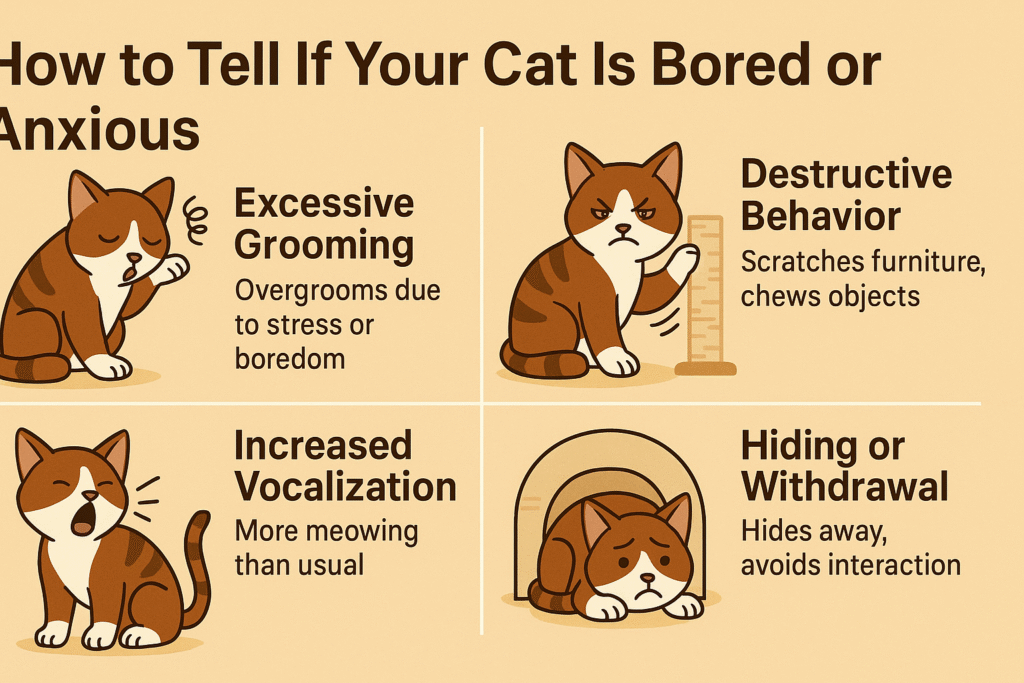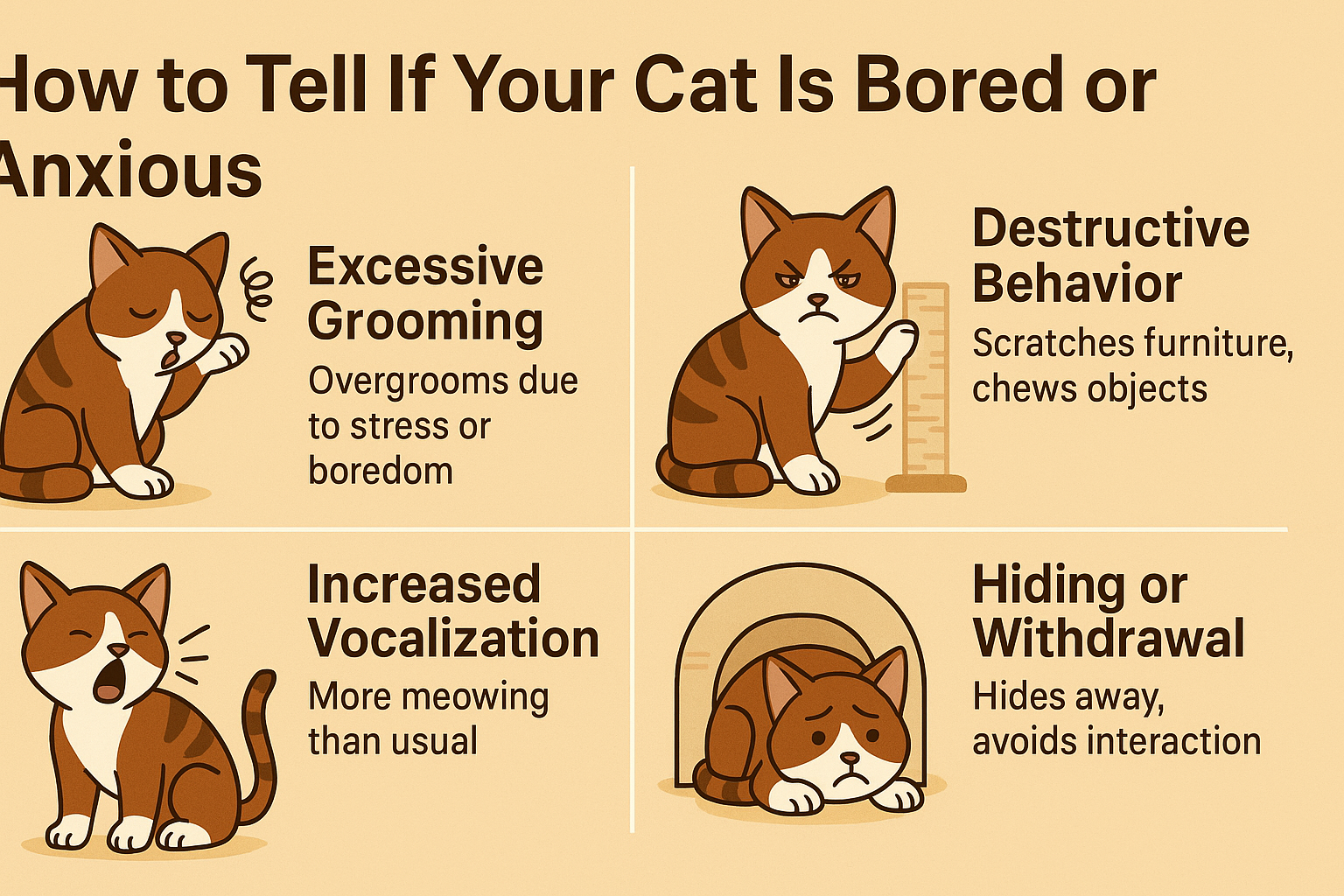Cats are often seen as independent and mysterious, but beneath their cool exterior, they experience a wide range of emotions. Boredom and anxiety are two of the most common emotional states that can affect a cat’s well-being.
As a cat owner, it’s important to recognize the signs of both boredom and anxiety, understand their causes, and learn how to address them for your feline friend’s health and happiness.
This comprehensive guide will help you spot the emotional cues that indicate boredom or anxiety in your cat, explain why these feelings arise, and provide practical solutions to keep your cat mentally and physically stimulated.
Understanding Cat Emotions: Boredom vs. Anxiety
Boredom in cats arises when their environment lacks stimulation. Cats are natural hunters and explorers, and when they don’t have enough to do, they can become restless, frustrated, and even develop behavioral problems.
Anxiety, on the other hand, is a state of unease or fear. It can be triggered by changes in the environment, lack of routine, or even as a consequence of chronic boredom. While the signs of boredom and anxiety often overlap, understanding the differences can help you provide the right support for your cat.
Why Do Cats Get Bored or Anxious?
Causes of Boredom
Cats, especially those kept indoors, can become bored if they lack opportunities to express their natural behaviors. Some of the main reasons include:
- Lack of outlets for predatory behaviors like climbing, stalking, pouncing, and chasing.
- A monotonous or unstimulating living environment.
- Limited opportunities to explore or interact with their surroundings.
- Not enough social interaction with humans or other animals.
- Insufficient exercise and playtime.
Indoor cats are particularly at risk, as their environment may not provide the variety and excitement they need to stay mentally engaged.
Causes of Anxiety
Anxiety in cats can stem from:
- Changes in the household, such as moving, new pets, or new family members.
- Lack of routine or unpredictability in daily life.
- Prolonged boredom, which can lead to frustration and stress.
- Medical issues or pain (always rule out health problems with your vet if you notice behavioral changes).
- Traumatic experiences or lack of socialization.

Spotting the Signs: Emotional Cues of Boredom and Anxiety
Cats are experts at hiding their emotions, but certain behaviors can reveal when something is wrong. Here are the most common signs to watch for:
1. Excessive Grooming
Overgrooming is a classic sign of both boredom and anxiety. If your cat is licking or biting themselves more than usual, to the point of losing fur or developing skin irritation, they may be trying to cope with stress or a lack of stimulation. This repetitive behavior is known as a “stereotypic behavior” and is a red flag for psychological stress.
2. Destructive Behavior
Bored cats often find their own entertainment, which can result in:
- Scratching furniture or carpets.
- Chewing on cords, plants, or other household items.
- Knocking objects off shelves or countertops.
These actions are not acts of defiance, but attempts to relieve pent-up energy and frustration.
3. Increased Vocalization
If your cat is meowing, yowling, or howling more than usual, they may be trying to get your attention or express their need for stimulation. Excessive vocalization can also be a sign of anxiety, especially if your cat seems distressed or is vocalizing when left alone.
4. Lack of Interest in Toys or Play
A bored cat may lose interest in toys that once excited them. If your cat ignores playtime or seems indifferent to new toys, it could indicate that they are not mentally engaged or are feeling down.
5. Sleeping More Than Usual
While it’s normal for cats to sleep 12–18 hours a day, a noticeable increase in sleep or lethargy can be a sign of boredom or depression. Cats may sleep to pass the time when there’s nothing else to do.
6. Attention-Seeking Behavior
Bored cats may become clingy, paw at you, follow you around, or demand constant petting and interaction. They are seeking stimulation and engagement from their human companions.
7. Overeating or Loss of Appetite
Changes in eating habits, such as overeating or a sudden loss of appetite, can be linked to emotional distress. Emotional eating is common in bored cats, while anxious cats may lose interest in food.
8. Aggression
Boredom and anxiety can both lead to increased aggression, either toward humans or other pets. This can include biting, scratching, fighting, or stalking other animals in the household.
9. Inappropriate Elimination
Cats may urinate or defecate outside the litter box due to stress, anxiety, or frustration. This is especially common if there have been changes in the household or if the cat feels insecure or bored.
10. Zoomies and Restlessness
Frequent episodes of frantic running or “zoomies” can be a sign that your cat has excess energy and is not getting enough stimulation. While occasional zoomies are normal, daily or frequent episodes suggest boredom.
11. Pacing and Restlessness
Anxious or bored cats may pace back and forth, unable to settle. This can be a sign that they are not content or are looking for something to do.
12. Hiding or Withdrawal
Some cats respond to anxiety or chronic boredom by withdrawing from social interaction, hiding, or avoiding contact with people and other pets.
How to Tell the Difference: Boredom vs. Anxiety
While many signs overlap, there are subtle differences:
| Symptom | Boredom | Anxiety |
| Overgrooming | Common | Common |
| Destructive behavior | Common | Less common, unless stressed |
| Increased vocalization | Common, attention-seeking | Common, especially when alone |
| Sleeping more | Common | Sometimes, but may also pace |
| Attention-seeking | Very common | May seek comfort, or may withdraw |
| Aggression | Often playful or mischievous | Defensive or fearful |
| Inappropriate elimination | Less common, but possible | More common, especially with stress |
| Hiding | Rare | Very common |
If your cat’s behavior changes suddenly, or if you notice signs of distress, always consult your veterinarian to rule out medical causes before assuming the issue is emotional.
Why Spotting These Cues Matters
Recognizing boredom or anxiety in your cat is not just about preventing bad behavior. Chronic emotional distress can have real health consequences, including:
- Weight gain or obesity from overeating.
- Skin problems from overgrooming.
- Urinary tract issues from inappropriate elimination.
- Weakened immune system due to chronic stress.
- Reduced quality of life and shortened lifespan.
Early intervention can make a significant difference in your cat’s health and happiness.
What To Do If Your Cat Is Bored or Anxious?
1. Enrich Their Environment
Cats need opportunities to climb, scratch, hide, and explore. Consider adding:
- Cat trees, shelves, or window perches for climbing and observing.
- Scratching posts and pads in multiple locations.
- Puzzle feeders or treat-dispensing toys to stimulate their hunting instincts.
- Cardboard boxes, paper bags, or tunnels for hiding and playing.
2. Increase Playtime
Dedicate time each day for interactive play using wand toys, laser pointers, or feather teasers. Vary the toys and play styles to keep your cat interested. Play sessions should mimic hunting behaviors: stalking, chasing, pouncing, and capturing.
3. Rotate Toys
Cats can become bored with the same toys. Rotate toys weekly to keep them novel and exciting.
4. Provide Visual Stimulation
Place bird feeders outside windows or play videos designed for cats. Watching wildlife can provide hours of entertainment.
5. Encourage Social Interaction
Spend quality time with your cat through petting, grooming, or gentle conversation. Some cats enjoy learning tricks or playing fetch.
6. Create Predictable Routines
Cats feel more secure with a consistent daily routine. Feed, play, and interact at the same times each day to reduce anxiety.
7. Address Litter Box Issues
Keep litter boxes clean and in quiet, accessible locations. If your cat is eliminating outside the box, consult your vet to rule out medical problems and consider whether stress or boredom is a factor.
8. Consider a Companion
If your cat is very social and you have the resources, adopting another cat can provide companionship and play opportunities. However, introduce new pets slowly and monitor their interactions.
9. Use Calming Products
Products like pheromone diffusers or calming collars can help reduce anxiety in some cats. Always consult your vet before introducing new products.
10. Seek Veterinary Advice
If your cat’s behavior does not improve with enrichment and routine changes, consult a veterinarian or a certified animal behaviorist. Underlying medical or psychological issues may require professional intervention.
Advanced Tips for Managing Cat Boredom and Anxiety
Once you have addressed the basics of enrichment and routine, there are additional strategies you can use to further support your cat’s emotional health.
1. Training and Mental Challenges
Cats are intelligent animals and can benefit from training sessions. Teaching your cat simple commands like “sit” or “come” using positive reinforcement stimulates their brain and strengthens your bond. Puzzle toys that require problem-solving to access treats also keep their minds sharp.
2. Outdoor Exploration (Safely)
If possible, allow your cat to experience the outdoors safely. This can be through supervised leash walks, a secure catio (an enclosed outdoor space), or a window perch that offers fresh air. Outdoor sights, sounds, and smells provide natural enrichment that indoor environments often lack.
3. Use of Interactive Technology
There are now interactive devices designed for cats, such as automatic laser toys or robotic prey-like toys. These devices can keep your cat entertained when you are not home, helping to reduce boredom.
4. Mindful Observation
Spend time observing your cat’s behavior to learn what activities or toys they prefer. Some cats enjoy chasing moving objects, while others prefer quiet napping spots or puzzle feeders. Tailoring enrichment to your cat’s personality is key.
5. Manage Environmental Stressors
Identify and minimize sources of stress in your cat’s environment. Loud noises, other aggressive pets, or sudden changes can increase anxiety. Creating quiet, safe spaces where your cat can retreat is important.
Common Mistakes Cat Owners Make
Even with the best intentions, some approaches may inadvertently worsen boredom or anxiety.
- Ignoring subtle signs: Cats are masters at hiding distress. Don’t wait for extreme behaviors before taking action.
- Over-reliance on toys: Toys are helpful but cannot replace social interaction and environmental variety.
- Inconsistent routines: Changing feeding or play schedules frequently can increase anxiety.
- Punishing unwanted behavior: Punishment can increase fear and anxiety. Instead, redirect your cat’s energy to appropriate activities.
- Neglecting veterinary care: Behavioral changes can indicate medical issues. Always rule out health problems first.
Frequently Asked Questions (FAQs)
How can I tell if my cat is truly bored or just tired?
Bored cats usually show signs of restlessness, destructive behavior, or attention-seeking. Tired cats will typically find a quiet spot to nap and appear relaxed. If your cat is sleeping excessively but seems irritable or destructive when awake, boredom may be the cause.
Can anxiety in cats cause health problems?
Yes, chronic anxiety can weaken the immune system, cause digestive issues, and lead to overgrooming that damages the skin. It can also contribute to urinary problems due to stress-related behaviors.
What are some signs of severe anxiety in cats?
Severe anxiety may include constant pacing, hiding for long periods, refusal to eat, aggressive outbursts, and excessive vocalization. If you notice these signs, consult a veterinarian promptly.
Are there any natural remedies for cat anxiety?
Some natural options include pheromone diffusers (like Feliway), herbal supplements, and calming sprays. Always discuss these with your vet before use to ensure safety and effectiveness.
How often should I play with my cat to prevent boredom?
Daily play sessions of at least 10-15 minutes, two to three times a day, are ideal. Short, frequent sessions mimic a cat’s natural hunting patterns and help keep them engaged.
Conclusion
Understanding whether your cat is bored or anxious is crucial to providing the right care. Both emotional states can lead to behavioral problems and health issues if left unaddressed. By carefully observing your cat’s behavior, recognizing emotional cues, and making thoughtful changes to their environment and routine, you can improve their quality of life significantly.
Remember, every cat is unique. What works for one may not work for another. Patience, attention, and love are the best tools you have to help your feline friend thrive emotionally and physically. If ever in doubt, don’t hesitate to seek professional advice from your veterinarian or a qualified animal behaviorist.
Your cat depends on you not just for food and shelter but for emotional well-being. With the right knowledge and care, you can ensure your cat lives a happy, fulfilled life free from boredom and anxiety.
References
- American Association of Feline Practitioners (AAFP). “Environmental Needs of Cats.” catvets.com
- ASPCA. “Understanding Cat Behavior.” aspca.org
- Cornell University College of Veterinary Medicine. “Feline Behavior Problems.” vet.cornell.edu
- The Humane Society of the United States. “Cat Behavior and Training.” humanesociety.org
- International Cat Care. “Stress and Cats.” icatcare.org
- Parrotlets (Personality, Care, Health, Nutrition, & Cost) - June 20, 2025
- Caique (Personality, Care, Health, & Nutrition) - June 20, 2025
- The Complete Guide to Golden Retrievers - June 9, 2025















